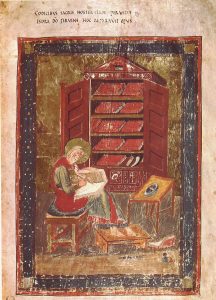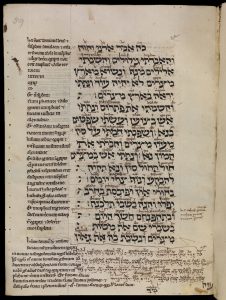Recently we received an interesting question on Discord: “Does anyone know the reason the Hebrew script changed from Paleo-Hebrew to Hebrew and even when?”
This is a fascinating question. Before we answer it let’s have a brief look at some historical context.
Era of The First Temple
During the era of the First Temple, which stood from around 1000 B.C.E. the written Hebrew language used was known as Paleo Hebrew. This ancient script lacked spaces between letters and did not include final letters (sofiyot). It served as the written form of communication for the Hebrew people during that time.
When the First Temple was destroyed in 586 B.C.E, the Israelites were exiled to Babylon. At that time, the Persian Empire came to power, as mentioned in the Book of Esther. The Persian king granted the Hebrews autonomy to return to their land and build the Second Temple.

The Natan-Melech/Eved Hamelech bulla (seal impression) dated to the First Temple period.
Meanwhile, in Greece, a philosopher named Socrates was teaching wisdom and questioning conventional knowledge. Socrates’ teachings were marked by his famous Socratic method, through which he engaged in dialogues with his students, encouraging critical thinking and self-examination. He challenged the prevailing beliefs and encouraged individuals to question their own assumptions and biases.
It is remarkable that during this period of intellectual exploration in Greece, Ezra, a prominent figure among the Hebrew people, initiated a series of reforms that would shape the future of the Hebrew language and daily practices.
Under The Persian Empire
Under the rule of the Persian Empire, the Hebrews were granted autonomy to return to their land and rebuild the sacred Temple. Ezra, who played a pivotal role in this process, recognized the need for a unified linguistic system as the diverse population returned from exile. He introduced significant reforms to both the script and usage of Hebrew.
In this context, Ezra’s reforms were not only a response to the needs of the Hebrew people but also a reflection of the intellectual climate of the time. While Socrates in Greece was teaching wisdom and encouraging critical thinking, Ezra was transforming the Hebrew language according to the intellectual shift within his own culture.
Ezra’s reforms went beyond the script itself. He introduced spaces between words, a punctuation mark (a dot) to signify the end of a sentence, and the incorporation of Te’amim marks. These Te’amim marks, also known as cantillation marks, provided musical notations that assisted in the accurate pronunciation of the sacred texts.
Second Temple
In building the Second Temple, Ezra’s reforms found their manifestation. He not only focused on the physical construction but also sought to create a spiritual center for the Hebrew people. Ezra understood the importance of not only establishing buildings but also fostering a way of life that would support a deep connection with the divine.
As part of his efforts, Ezra taught the people to read and write Hebrew. He initiated the practice of reading the Torah twice a week, on Mondays and Thursdays, to maintain a continuous connection to the sacred texts. By dividing the Torah into portions, he ensured that the entire Torah would be completed over the course of a year.
This reading structure originally developed by Ezra about 2500 years ago continues until this very day in Hebrew communities all over the world.

Ezra writes the Bible
Just like the intellectual activities of Socrates rippled through the centuries and greatly affected developments across European cultures, the actions of Ezra were similarly groundbreaking for Hebrew language and culture.
The parallel intellectual endeavors in both Greece and Hebrew society during this period highlight the significance of critical thinking, questioning beliefs, and seeking deeper understanding.
New Foundations
The reforms of Ezra, and their emphasis on literacy and the spiritual life of the people, became the foundation upon which the Second Temple was built. His efforts were instrumental in preserving the Hebrew language, reviving its usage, and nurturing a renewed sense of faith and identity among the Hebrews during that pivotal period.

The book of Ezekiel. English and Hebrew manuscript from early 13th century.
In short, the transformation of the Hebrew language occurred around the 5th century B.C.E. due to the pressing need to adapt to the changing times.
The destruction of the First Temple, the exile in Babylon, and the rise of the Parthian Empire created circumstances that called for significant reforms. Ezra, recognizing these needs, introduced crucial changes to the Hebrew script, including the addition of spaces, punctuation, and musical notations.
These reforms aimed to unify the people, facilitate communication, and ensure the preservation of their language and daily practices during a period of great upheaval.
–
